栈
概念
栈:一种特殊的线性表,其只允许在固定的一端进行插入和删除元素操作。进行数据插入和删除操作的一端称为栈顶,另一端称为栈底。栈中的数据元素遵守后进先出LIFO(Last In First Out)的原则.
其两种操作方式:
压栈:也就是数据的插入,插入位置在栈顶。
出栈:栈的删除,删除位置在栈顶。
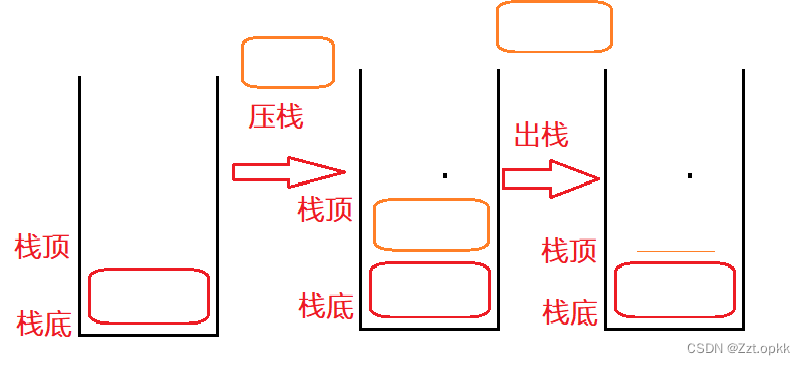
栈的使用
| 方法 | 功能 |
|---|---|
| Stack() | 构造一个空的栈 |
| E push(E e) | 将e入栈,并返回e |
| E pop() | 将栈顶元素出栈并返回 |
| E peek() | 获取栈顶元素 |
| int size() | 获取栈中有效元素个数 |
| boolean empty() | 检测栈是否为空 |
public static void main(String[] args) {
Stack<Integer> stack = new Stack<>();
/**
* 压栈,在栈顶放入
*/
stack.push(1);
stack.push(2);
stack.push(3);
/**
* 出栈,把栈顶元素弹出并返回
*/
System.out.println(stack.pop());
/**
* 返回栈顶元素,不删除
*/
System.out.println(stack.peek());
/**
* 获取当前栈中元素个数
*/
System.out.println(stack.size());
/**
* 检查栈是否为空
*/
System.out.println(stack.empty());
}
栈的模拟实现
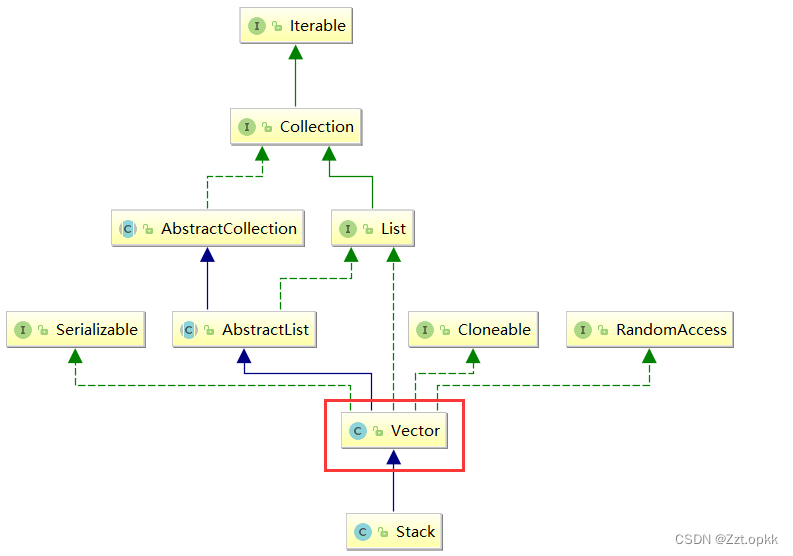
public class MyStack {
private int[] elem;
private int usedSize;
public MyStack() {
this.elem = new int[5];
}
public int pop() {
if (isEmpty()) {
throw new RuntimeException("栈为空!");
}
int oldVal = elem[usedSize - 1];
usedSize--;
return oldVal;
}
private boolean isFull() {
return this.usedSize == elem.length;
}
public boolean isEmpty() {
return this.usedSize == 0;
}
public int peek() {
if (isEmpty()) {
throw new RuntimeException("栈为空!");
}
return elem[usedSize - 1];
}
public int push(int item) {
if (isFull()) {
this.elem = Arrays.copyOf(elem,elem.length * 2);
}
elem[usedSize++] = item;
return item;
}
}
栈的应用场景
- 把递归转化为循环
例如递归打印链表
void printList(Node head){
if(null != head){
printList(head.next);
System.out.print(head.val + " ");
}
}
循环方式打印
void printList(Node head){
if(null == head){
return;
}
Stack<Node> s = new Stack<>();
Node cur = head;
while(null != cur){
s.push(cur);
cur = cur.next;
}
// 将栈中的元素出栈
while(!s.empty()){
System.out.print(s.pop().val + " ");
}
}
- 括号匹配
给定一个只包括 ‘(’,‘)’,‘{’,‘}’,‘[’,‘]’ 的字符串 s ,判断字符串是否有效。
有效字符串需满足:
- 左括号必须用相同类型的右括号闭合。
- 左括号必须以正确的顺序闭合。
思路:每一个左括号都有其对应的右括号,所以我们所以栈来检查每一次的括号是否匹配,遇到左括号入栈,然后检查下一个括号是否和它匹配,匹配则出栈,继续检查。
class Solution {
public boolean isValid(String s) {
Stack<Character> stack = new Stack<>();
for (int i = 0; i < s.length(); i++) {
char c = s.charAt(i);
if (c == '(' || c == '[' || c == '{') {
stack.push(c);
}
if (stack.empty()) {
return false;
}
if (c == ')' && stack.pop() != '(') {
return false;
} else if (c == '}' && stack.pop() != '{') {
return false;
} else if (c == ']' && stack.pop() != '[') {
return false;
}
}
return stack.empty();
}
}
可以优化,先根据本次左括号压入对应右括号,在检查下一次是否括号是否匹配
class Solution {
public boolean isValid(String s) {
Stack<Character> stack = new Stack<>();
for (char c : s.toCharArray()) {
if (c == '(') {
stack.push(')');
} else if (c == '[') {
stack.push(']');
} else if (c == '{') {
stack.push('}');
} else if (stack.isEmpty() || c != stack.pop()) {
return false;
}
}
return stack.isEmpty();
}
}
- 逆波兰表达式求值
逆波兰表达式的特点是:没有括号,运算符总是放在和它相关的操作数之后。因此,逆波兰表达式也称后缀表达式。
思路:逆波兰表达式严格遵循「从左到右」的运算,所以我们可以用栈来存储数据,遇到运算符则弹出两个元素,注意第一个弹出的为右操作数,第二个弹出的为左操作数,然后把计算出的结果放入栈中,直到没有数据。
class Solution {
public int evalRPN(String[] tokens) {
Stack<Integer> stack = new Stack<>();
for (String val : tokens) {
//如果不是运算符
if (!isOperation(val)) {
stack.push(Integer.parseInt(val));
} else {
//出栈并且计算
//定义左右操作数,注意:第一个出栈的是右操作数
int num2 = stack.pop();
int num1 = stack.pop();
switch(val) {
case "/" :
stack.push(num1 / num2);
break;
case "*" :
stack.push(num1 * num2);
break;
case "+" :
stack.push(num1 + num2);
break;
case "-" :
stack.push(num1 - num2);
break;
}
}
}
return stack.pop();
}
private boolean isOperation(String s) {
if (s.equals("/") || s.equals("*") ||s.equals("-") ||s.equals("+")) {
return true;
}
return false;
}
}
- 出栈入栈次序匹配
思路:由于压栈的时候也可以出栈,所以每一次我们先把压入序列的元素和弹出序列元素比较,如果不相同,则压入元素,否则弹出元素,最后我们只需要判断栈是否为空
import java.util.ArrayList;
import java.util.Stack;
public class Solution {
public boolean IsPopOrder(int [] pushA,int [] popA) {
Stack<Integer> stack = new Stack<>();
int i = 0, j = 0;
for (;i < pushA.length; i++) {
stack.push(pushA[i]);
while (j < popA.length && !stack.empty() &&stack.peek() == popA[j]) {
stack.pop();
j++;
}
}
return stack.empty();
}
}
队列
概念
队列:只允许在一端进行插入数据操作,在另一端进行删除数据操作的特殊线性表,队列具有先进先出FIFO(First In First Out) 入队列:进行插入操作的一端称为队尾(Tail/Rear) 出队列:进行删除操作的一端称为队头(Head/Front)

队列的使用
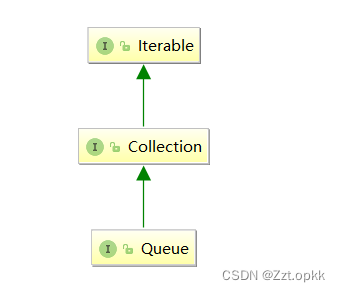
Queue是接口,底层是链表。
| 方法 | 功能 |
|---|---|
| boolean offer(E e) | 入队列 |
| E poll() | 出队列 |
| peek() | 获取队头元素 |
| int size() | 获取队列中有效元素个数 |
| boolean isEmpty() | 检测队列是否为空 |
public static void main(String[] args) {
Queue<Integer> queue = new LinkedList<>();
/**
* 入队,从尾入
*/
queue.offer(1);
queue.offer(2);
queue.offer(3);
/**
* 出队,出队头元素
*/
System.out.println(queue.poll());
/**
* 获取队头元素
*/
System.out.println(queue.peek());
/**
*获取队列中元素个数
*/
System.out.println(queue.size());
/**
* 检查队列是否为空
*/
System.out.println(queue.isEmpty());
}
队列的模拟实现
队列的模拟实现的底层逻辑可以用线性表和链表,我们分别使用二者实现:
- 链表
我们使用单链表实现,如果把head作为头则offer为O(n),poll为O(1),为了实现O(1)的时间复杂度,我们定义一个头,尾哨兵位,指向头和尾,这样可以达到O(1)。
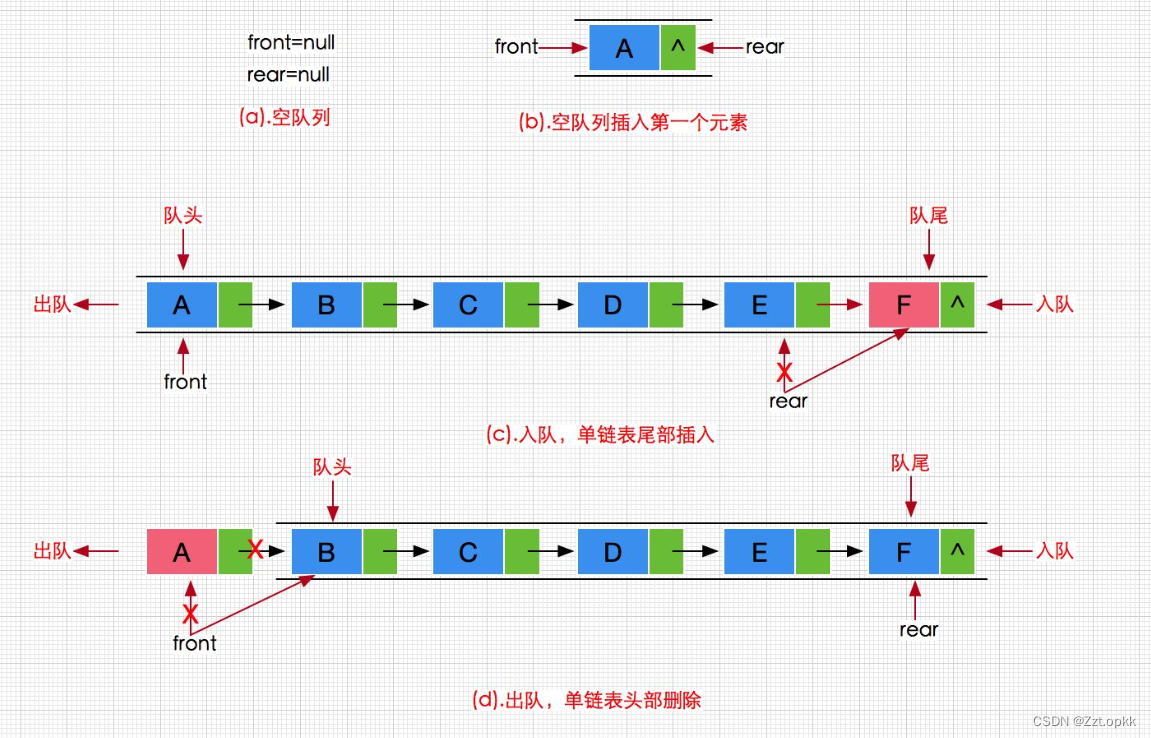
public class MyStack {
static class Node {
private int val;
private Node next;
public Node(int val) {
this.val = val;
}
}
private Node front;
private Node rear;
public int peek(){
if (isEmpty()) {
throw new RuntimeException("空");
}
return front.val;
}
public boolean isEmpty() {
return front == null;
}
public void offer(int e) {
Node node = new Node(e);
if (isEmpty()) {
rear = node;
front = node;
}
rear.next = node;
rear = node;
}
public int poll() {
if (isEmpty()) {
throw new RuntimeException("空");
}
int oldVal = front.val;
front = front.next;
return oldVal;
}
}
- 线性表
循环队列并不是物理空间循环,而是逻辑上是一个环。
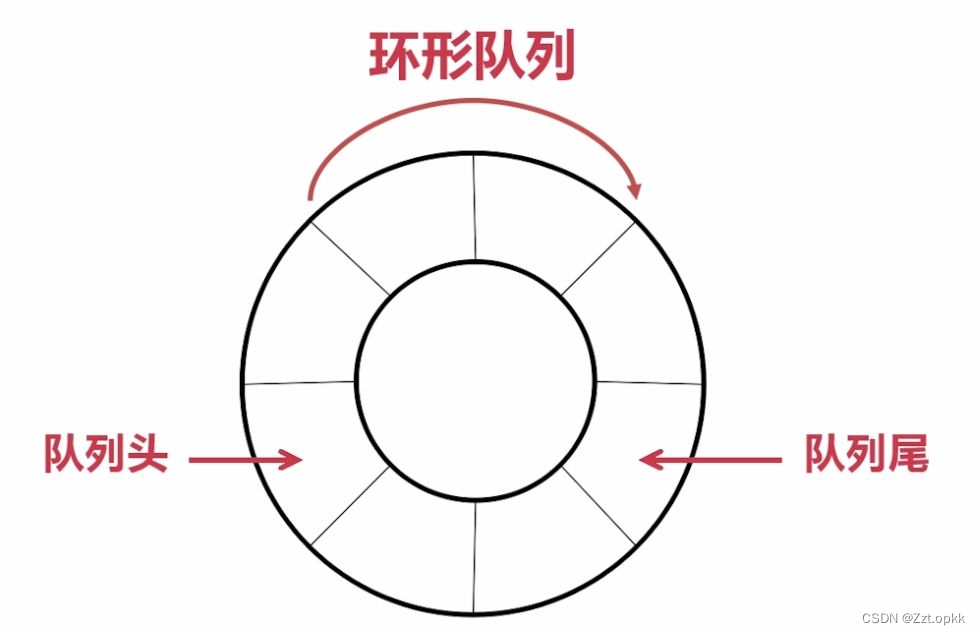
这里我们我们可以通过取余的操作来得到“循环”
index = (index + offset) % array.length
offset为偏移量,index为下标, array.length为数组长度。
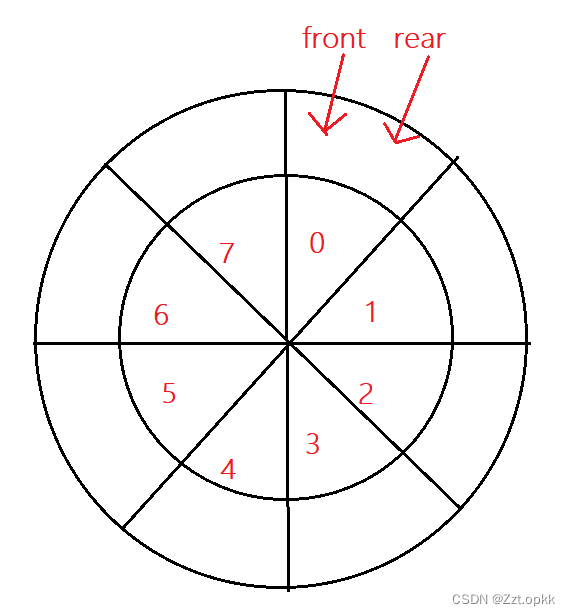
开始时头指针和尾指针都指向同一位置,那么我们如何判断数组已满呢?
- 添加size属性:添加元素size++,删除元素size–,当size == array.length时满
2.留一位置:每次添加元素后检查front 是否等于rear + 1 如图:
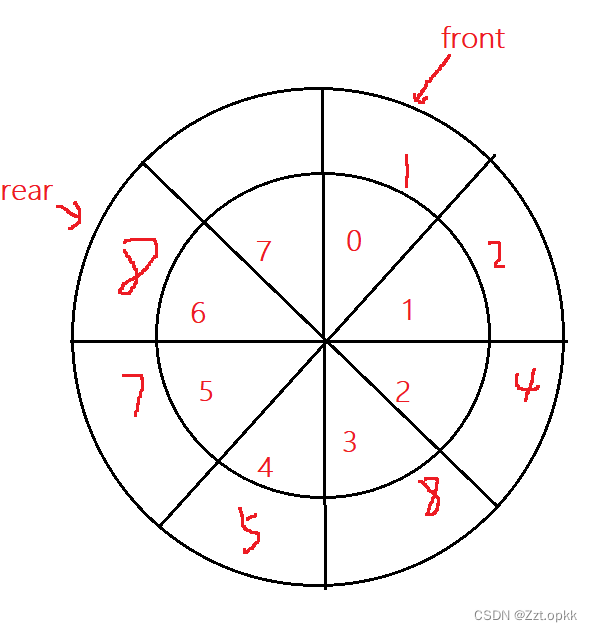
- 使用标记:定义一个flag初始为true,当二次相遇时,flag置为false,此时相遇。
class MyCircularQueue {
private int[] elem;
private int front;
private int rear;
public MyCircularQueue(int k) {
this.elem = new int[k + 1];
this.front = 0;
this.rear = 0;
}
public boolean enQueue(int value) {
if (isFull()) {
return false;
} else {
elem[rear] = value;
rear = (rear + 1) % elem.length;
return true;
}
}
public boolean deQueue() {
if (isEmpty()) {
return false;
}else {
front = (front + 1 ) % elem.length;
return true;
}
}
public int Front() {
if (isEmpty()) {
return -1;
}
return elem[front];
}
public int Rear() {
if (isEmpty()) {
return -1;
}
return elem[(rear - 1 + elem.length) % elem.length];
}
public boolean isEmpty() {
return this.rear == this.front;
}
public boolean isFull() {
if ((rear + 1) % elem.length == front) {
return true;
} else {
return false;
}
}
}
双端队列
双端队列(deque)是指允许两端都可以进行入队和出队操作的队列,deque 是 “double ended queue” 的简称。那就说明元素可以从队头出队和入队,也可以从队尾出队和入队.

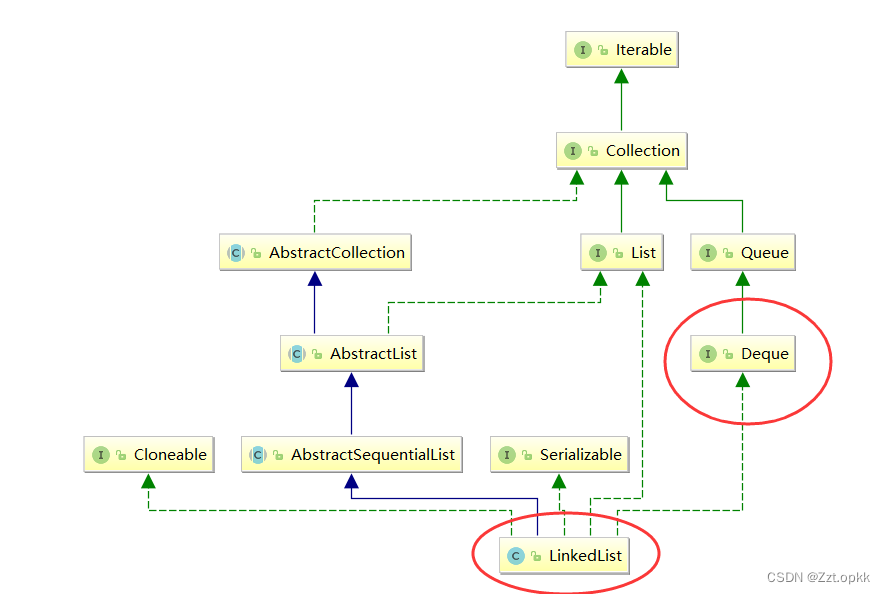
| 方法 | 功能 |
|---|---|
| offerFirst() | 插入元素到队头 |
| offerLast() | 插入元素到队尾 |
| pollFirst() | 删除队头元素 |
| pollLast() | 删除队尾元素 |
| peekFirst() | 返回队头元素 |
| peekLast() | 返回队尾元素 |
| isEmpty() | 检查队列是否为空 |
public static void main(String[] args) {
Deque<Integer> deque = new LinkedList<>();
/**
* 从队头入队
*/
deque.offerFirst(1);
deque.offerFirst(2);
/**
* 从队尾入队
*/
deque.offerLast(3);
deque.offerLast(4);
/**
* 队头元素出队
*/
deque.pollFirst();
/**
* 队尾元素出队
*/
deque.pollLast();
/**
* 返回队头元素
*/
System.out.println(deque.peekFirst());
/**
* 返回队尾元素
*/
System.out.println(deque.peekLast());
/**
* 检查队列是否为空
*/
System.out.println(deque.isEmpty());
}
面试题
- 用队列实现栈。链接
思路:用两个队列,一个用来push,一个用来pop
class MyStack {
private Queue<Integer> q;//pop
private Queue<Integer> p;//push
public MyStack() {
q = new LinkedList<>();
p = new LinkedList<>();
}
public void push(int x) {
p.offer(x);
//这里把q中的元素放入p中,完成倒置
while (!q.isEmpty()) {
p.offer(q.poll());
}
//然后交换q,p现在的q中元素序列就和栈一样
Queue tmp = q;
q = p;
p = tmp;
}
public int pop() {
return q.poll();
}
public int top() {
return q.peek();
}
public boolean empty() {
return q.isEmpty();
}
}
思路:一个队列,每次push时把队列倒置
class MyStack {
private Queue<Integer> q;
public MyStack() {
q = new LinkedList<>();
}
public void push(int x) {
int m = q.size();
q.offer(x);
//倒置队列
while (m-- > 0) {
q.offer(q.poll());
}
}
public int pop() {
return q.poll();
}
public int top() {
return q.peek();
}
public boolean empty() {
return q.isEmpty();
}
}
- 用栈实现队列 链接
思路:用两个栈一个接受数据,另一个输出数据,
class MyQueue {
private Stack<Integer> stack1;
private Stack<Integer> stack2;
public MyQueue() {
stack1 = new Stack<>();
stack2 = new Stack<>();
}
public void push(int x) {
stack1.push(x);
}
public int pop() {
if (!stack2.empty()) {
return stack2.pop();
} else {
while (!stack1.empty()) {
stack2.push(stack1.pop());
}
}
return stack2.pop();
}
public int peek() {
if (!stack2.empty()) {
return stack2.peek();
} else {
while (!stack1.empty()) {
stack2.push(stack1.pop());
}
}
return stack2.peek();
}
public boolean empty() {
return stack2.empty() && stack1.empty();
}
}
- 最小栈 链接
思路:一个普通栈接受数据,另一个记录当前元素中的最小值栈
class MinStack {
//普通栈
private Stack<Integer> stack;
//最小栈
private Stack<Integer> minStack;
public MinStack() {
stack = new Stack<>();
minStack = new Stack<>();
}
public void push(int val) {
stack.push(val);
//判断该值是否为最小值
if (minStack.empty() || val <= minStack.peek()) {
minStack.push(val);
}
}
public void pop() {
//删除元素为最小值时,minStack也要删除
if (!stack.empty()) {
int popVal = stack.pop();
if (minStack.peek() == popVal) {
minStack.pop();
}
}
}
public int top() {
if (!stack.empty()) {
return stack.peek();
}
throw new RuntimeException("栈为空");
}
public int getMin() {
if (!minStack.empty()) {
return minStack.peek();
}
throw new RuntimeException("栈为空!");
}
}
